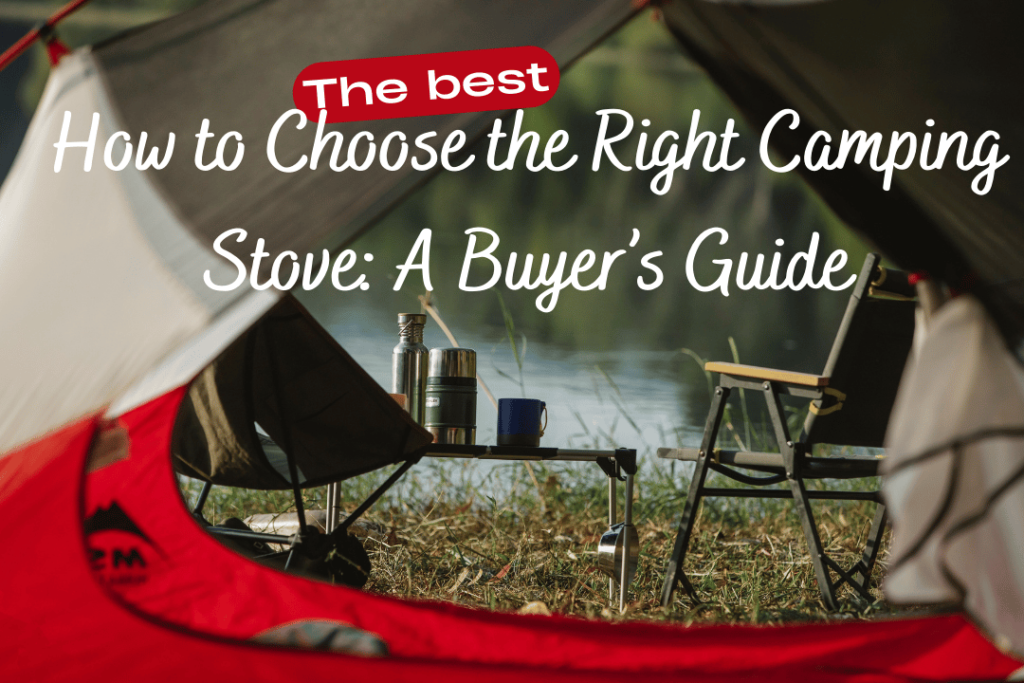A reliable camping stove can elevate your outdoor experience by making meal prep efficient and enjoyable. Whether you’re backpacking through rugged terrain or setting up a cozy campsite with your family, choosing the right camping stove is essential for satisfying meals. With a variety of options available, from lightweight backpacking stoves to multi-burner setups, the choice can feel overwhelming. This comprehensive guide will walk you through everything you need to know about selecting the perfect camping stove, ensuring your next outdoor adventure is both delicious and hassle-free.
1. Why Choosing the Right Camping Stove Matters
Selecting the right camping stove isn’t just about convenience—it’s about safety, efficiency, and enhancing your overall outdoor experience. A stove that’s too heavy, slow to heat, or difficult to use can turn meal times into a frustrating task. Here’s why choosing the right stove matters:
- Safety: The wrong stove can increase the risk of accidents, particularly in windy or unstable environments. A well-chosen stove will ensure safe cooking, even in adverse conditions.
- Efficiency: A good stove boils water quickly, uses fuel efficiently, and is reliable in various weather conditions. You don’t want to spend hours cooking or running out of fuel prematurely.
- Comfort: After a long day of hiking or exploring, the right stove will make it easier to whip up a hot meal and get back to relaxing by the campfire.
2. Types of Camping Stoves: Which is Right for You?
There are several types of camping stoves, each with its own pros and cons. The best stove for you depends on your camping style, the number of people you’re cooking for, and your culinary preferences.
Backpacking Stoves
Backpacking stoves are lightweight and compact, designed for hikers and solo campers who need to pack light. These stoves prioritize portability and efficiency over multi-burner convenience.
- Fuel Types: Typically use canister fuel (isobutane or propane) or liquid fuel (white gas, kerosene).
- Best For: Solo campers, hikers, and those who prioritize portability and quick meals.
- Pros: Lightweight, compact, and quick to set up.
- Cons: Limited cooking power, typically only supports small pots.
Canister Stoves
Canister stoves use pre-filled fuel canisters (usually isobutane or propane) that are lightweight and convenient. These stoves are easy to use and perfect for beginners or those who want simplicity.
- Fuel Types: Isobutane, propane.
- Best For: Short trips, backpacking, and ultralight camping.
- Pros: Easy to use, self-sealing canisters reduce fuel waste, reliable in most weather conditions.
- Cons: Canisters can be expensive, not suitable for extreme cold.
Liquid Fuel Stoves
Liquid fuel stoves are highly efficient, especially in cold or high-altitude environments. They run on white gas, kerosene, or unleaded gasoline, making them versatile for international travel.
- Fuel Types: White gas, kerosene, unleaded gasoline.
- Best For: Long-term camping, extreme cold, and high-altitude adventures.
- Pros: Reliable in extreme conditions, fuel is often cheaper and readily available.
- Cons: Heavier, more complex to maintain, requires priming.
Propane Stoves
Propane stoves are popular for car camping and family outings due to their power and ease of use. They typically come with one or more burners, offering more cooking flexibility.
- Fuel Types: Propane.
- Best For: Car camping, group cooking, and families.
- Pros: Easy to use, versatile, and provides strong heat.
- Cons: Bulky, heavier, propane tanks are less portable.
Wood-Burning Stoves
For campers looking for a more eco-friendly option, wood-burning stoves provide a fuel-free alternative by using natural wood or twigs found in your campsite.
- Fuel Types: Wood, twigs, pinecones.
- Best For: Survivalists, eco-conscious campers, bushcraft enthusiasts.
- Pros: No need to carry fuel, more environmentally friendly.
- Cons: Dependent on dry conditions, can be slower to cook with, and requires more effort to maintain the fire.
Multi-Fuel Stoves
If versatility is your priority, multi-fuel stoves allow you to switch between different types of fuel, such as canisters or liquid fuels, depending on availability. These stoves are ideal for those camping in various environments or traveling internationally.
- Fuel Types: Isobutane, propane, white gas, kerosene.
- Best For: International travel, remote camping, and unpredictable fuel availability.
- Pros: Versatile and reliable, especially in remote areas where fuel options may vary.
- Cons: Heavier, more expensive, and sometimes more complex to operate.
3. Key Factors to Consider When Choosing a Camping Stove
Once you understand the different types of camping stoves, it’s essential to consider the following factors to narrow down your options and find the best stove for your needs.
1. Weight and Portability
- Backpacking Stoves: If you’re hiking long distances, weight and size are critical. Choose an ultralight stove, typically under 1 pound, that won’t weigh down your pack.
- Car Camping Stoves: When weight isn’t an issue, opt for a more robust, multi-burner propane stove, perfect for family meals or group cooking.
2. Fuel Efficiency
Fuel efficiency becomes especially important on longer trips where resupplying isn’t an option. Canister stoves are known for their efficiency, while liquid fuel stoves are reliable for extended use in cold conditions.
- High-Efficiency Stoves: Look for stoves with built-in wind screens or pressure-regulation systems for better fuel economy in windy or cold conditions.
3. Burners and Cooking Surface
- Single Burner: Ideal for solo campers or minimalists who only need to boil water or cook simple meals.
- Multiple Burners: A two- or three-burner stove is perfect for group cooking or preparing more elaborate meals. Multiple burners allow you to cook different dishes simultaneously.
4. Cooking Power (BTUs)
BTUs (British Thermal Units) measure the heat output of a stove. The higher the BTU, the faster the stove can boil water and cook meals.
- Standard Cooking: 5,000-10,000 BTUs are typically sufficient for most camp cooking needs.
- Faster Cooking/Group Meals: Stoves with higher BTUs (up to 20,000) are ideal for quickly boiling water or cooking larger meals for groups.
5. Ease of Use
Camping stoves should be intuitive and easy to set up, even in less-than-ideal conditions. Look for features like:
- Push-Button Ignition: Eliminates the need for matches or lighters.
- Fuel Level Indicator: Allows you to monitor your fuel consumption.
- Adjustable Flame Control: Lets you simmer or boil with precision.
6. Stability and Durability
Ensure your camping stove has sturdy legs and a stable base, especially if you plan to use it on uneven surfaces. The construction should be durable enough to withstand rough outdoor conditions.
- Stability: Check for broad, non-slip bases, and make sure the stove can hold large pots without tipping over.
- Material: Stainless steel and aluminum are popular choices for durable, long-lasting stoves.
4. Top Features to Look For in a Camping Stove
When comparing different camping stoves, consider the following additional features that can enhance your camping cooking experience:
- Wind Resistance: A built-in windscreen or wind-resistant design ensures your stove functions well even in breezy conditions.
- Simmer Control: A stove that offers adjustable flame settings can make it easier to cook a variety of dishes, from simmering sauces to rapidly boiling water.
- Built-In Ignition: Many modern camping stoves come with push-button ignitions, making it easier to start a fire without the hassle of matches or lighters.
- Fuel Efficiency Technologies: Look for stoves that use pressure regulation or other technologies to maximize fuel efficiency, especially for longer trips.
5. Budget Considerations: How Much Should You Spend on a Camping Stove?
Camping stoves come in a wide range of prices, from budget-friendly models under $50 to high-end, multi-burner setups that cost $200 or more. Consider how often you plan to camp and what your cooking needs will be:
- Budget Stoves ($30-$70): Ideal for occasional campers, solo trips, or those who need a simple, lightweight stove for basic cooking.
- Mid-Range Stoves ($70-$150): Perfect for regular campers, car camping families, or those who want a good balance between power, durability, and price.
- High-End Stoves ($150+): Designed for frequent campers, large groups, or those who demand the highest performance and reliability.
Conclusion
Choosing the right camping stove is about understanding your unique needs and balancing factors like weight, cooking power, fuel efficiency, and ease of use. Whether you’re a solo backpacker seeking a compact stove or a family camper looking for a multi-burner setup, the perfect camping stove is out there waiting to enhance your outdoor adventures. By carefully considering the factors outlined in this guide, you’ll be well-equipped to make an informed decision and enjoy delicious meals no matter where your camping journey takes you



